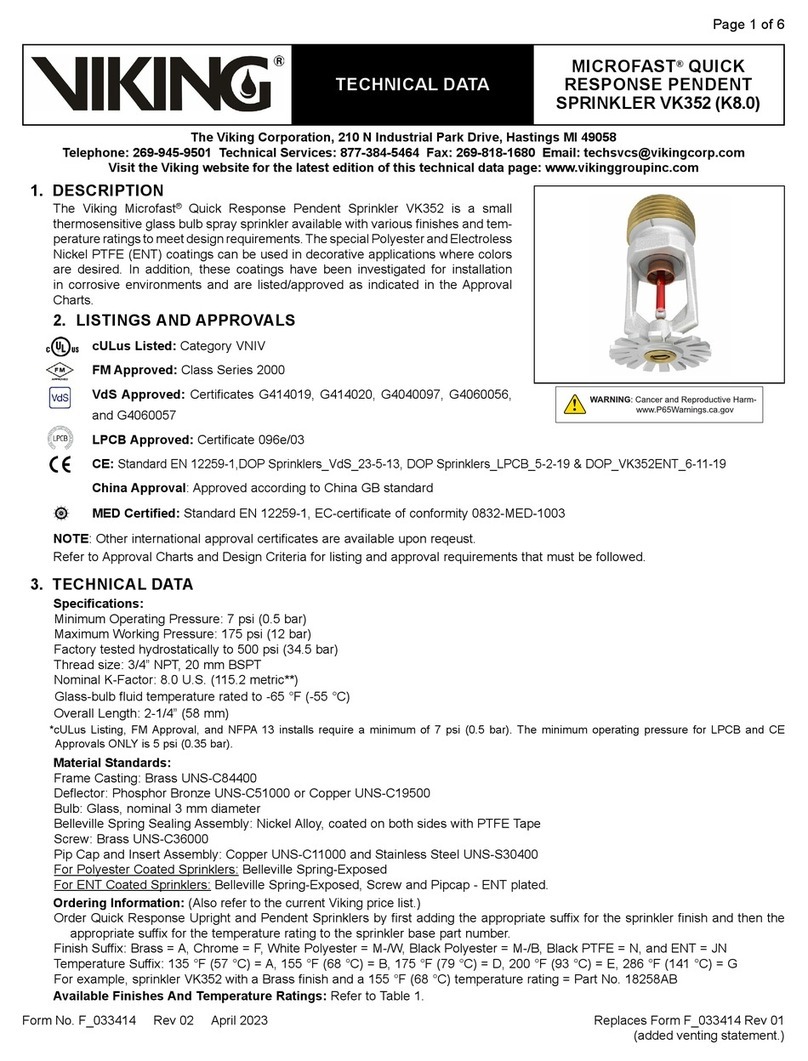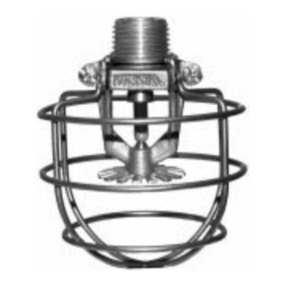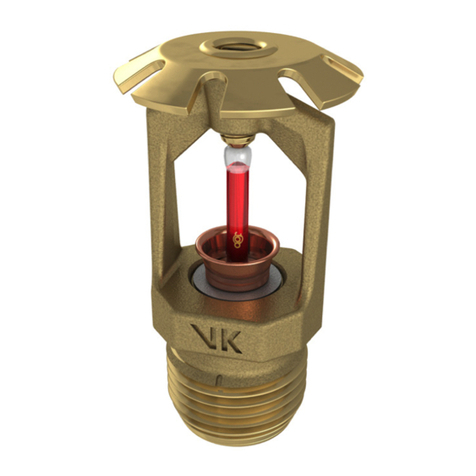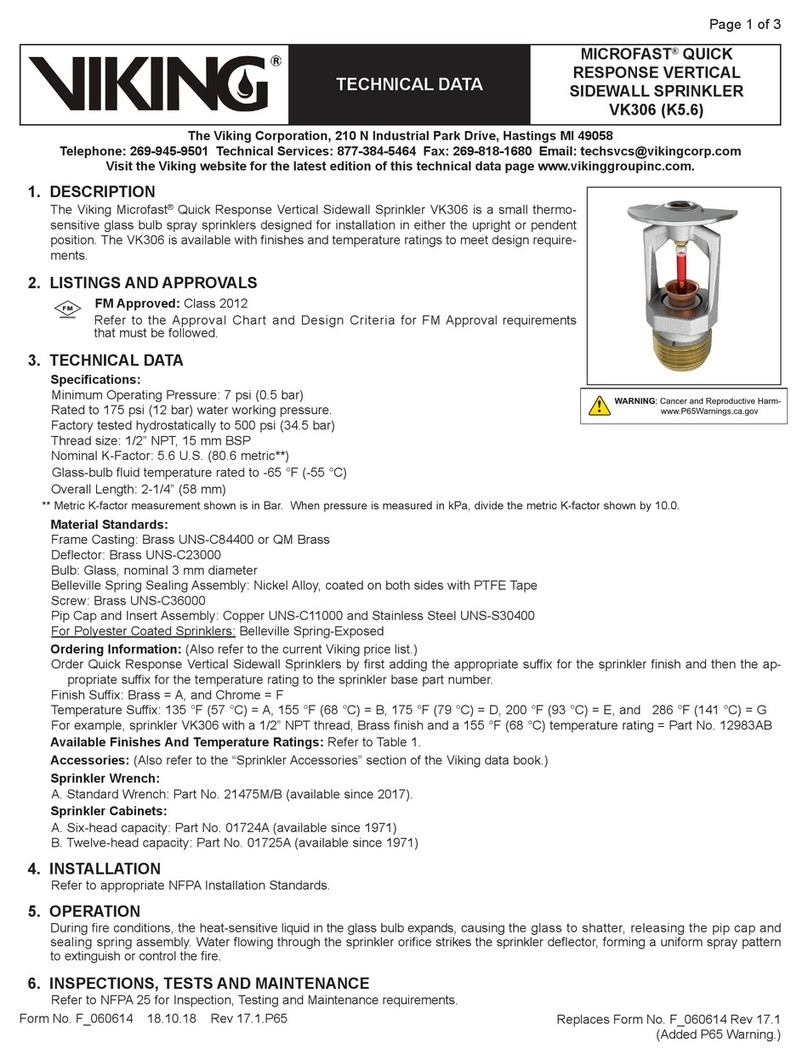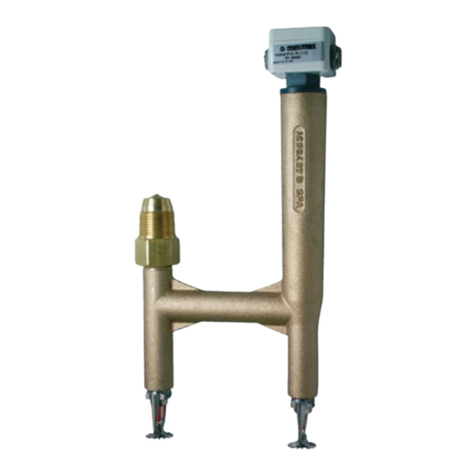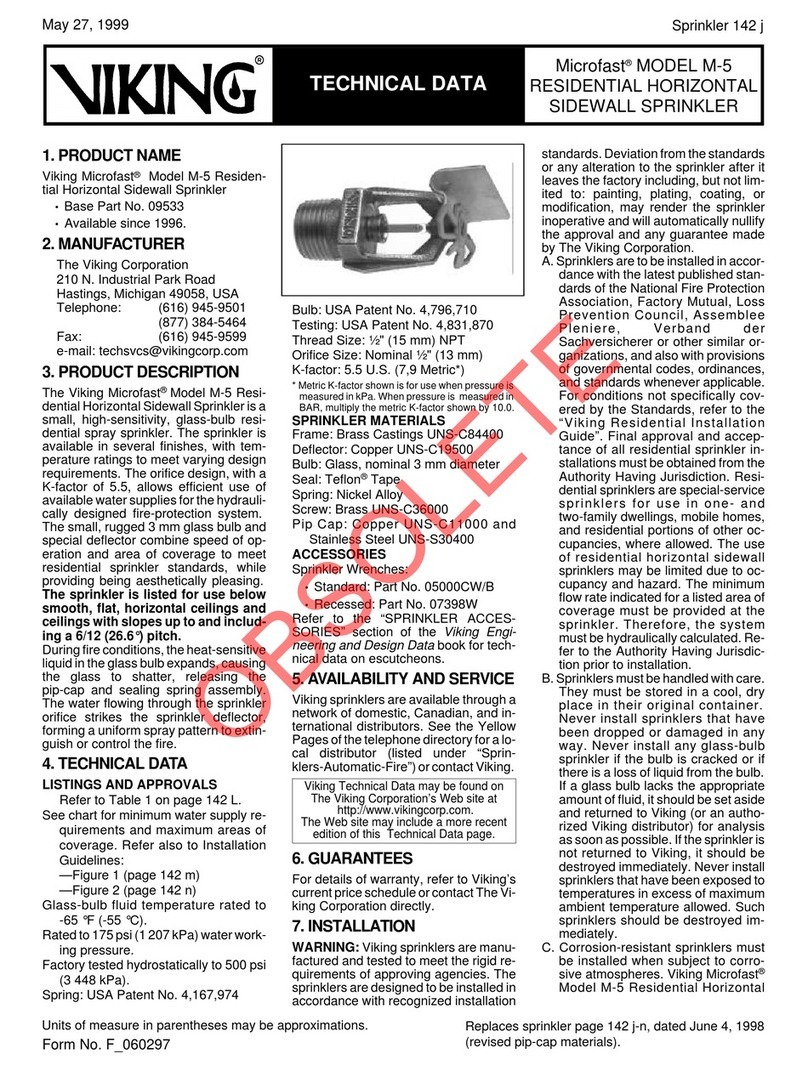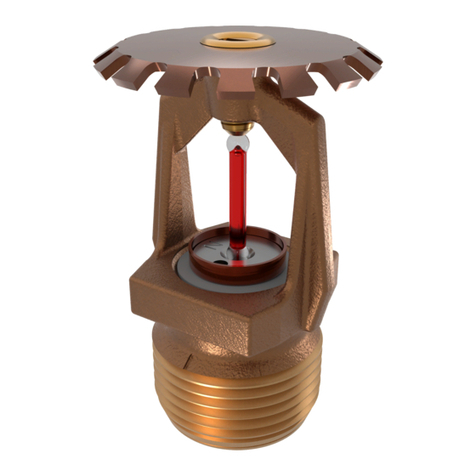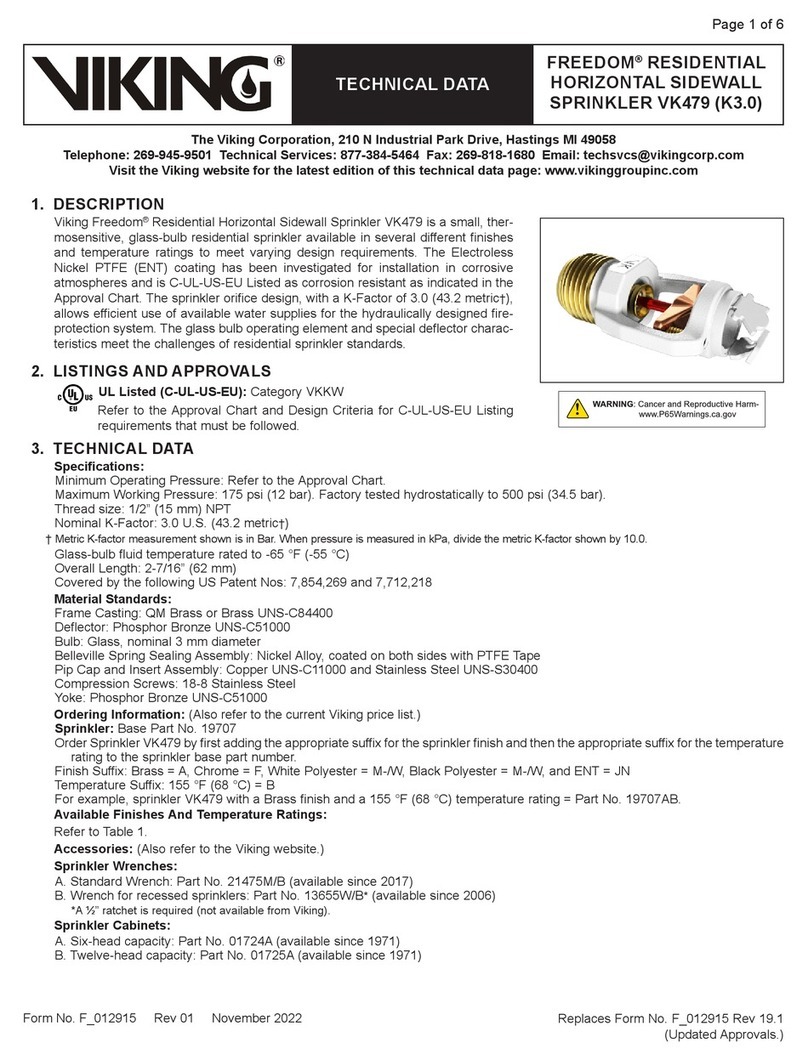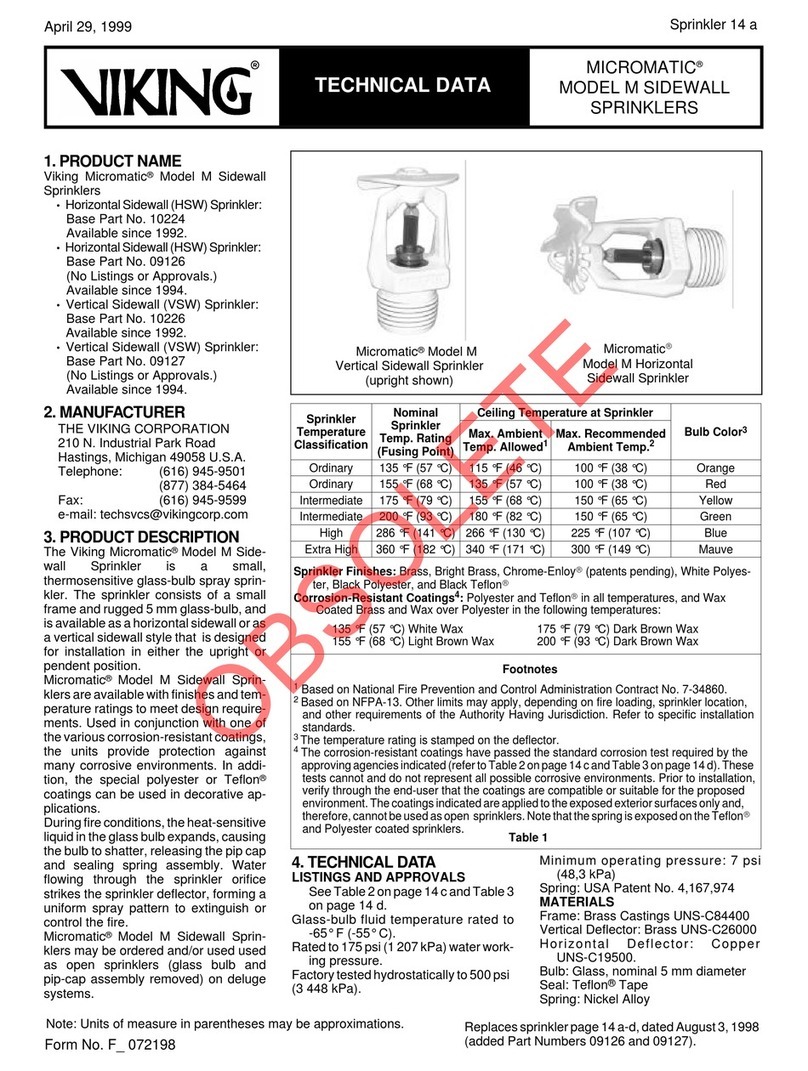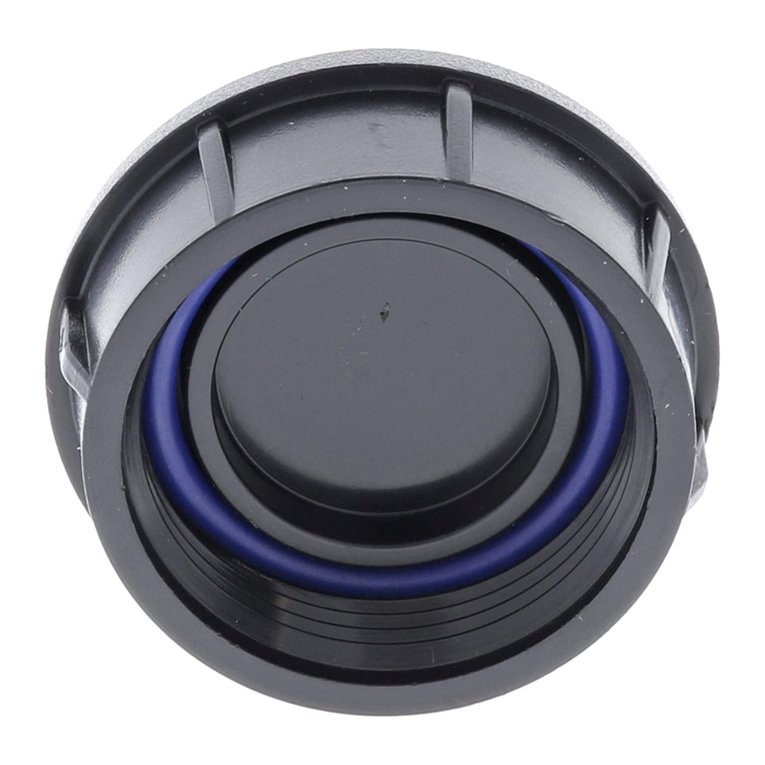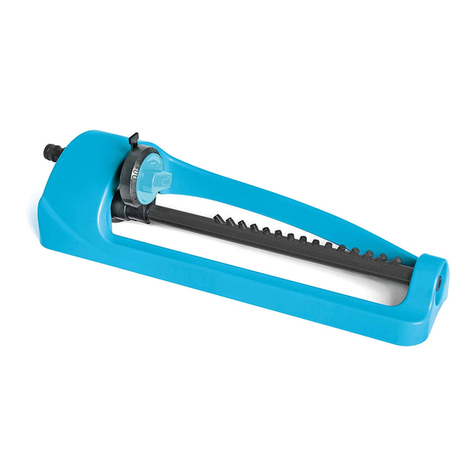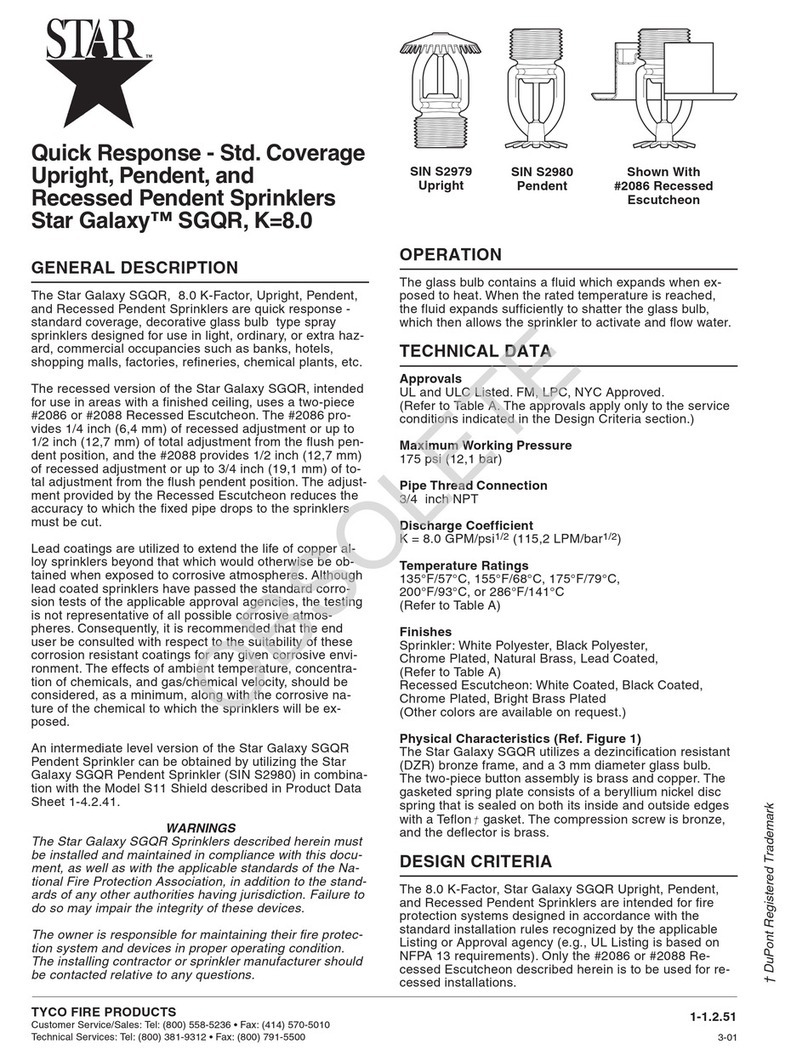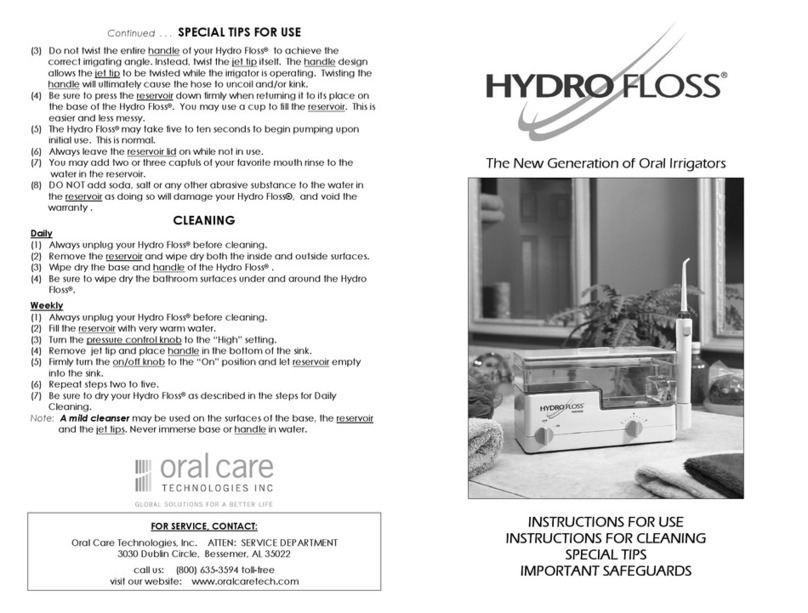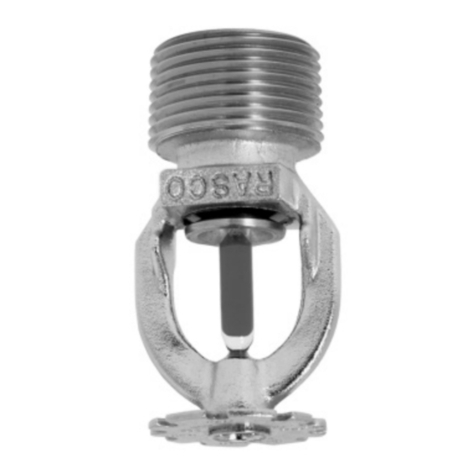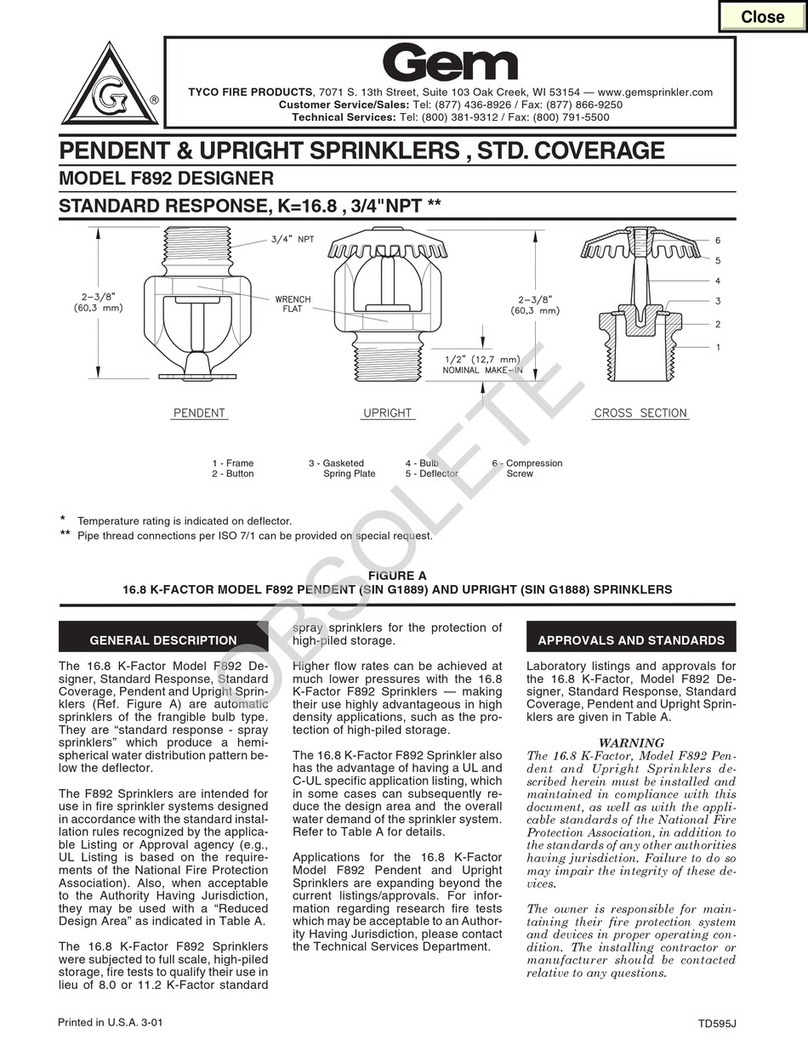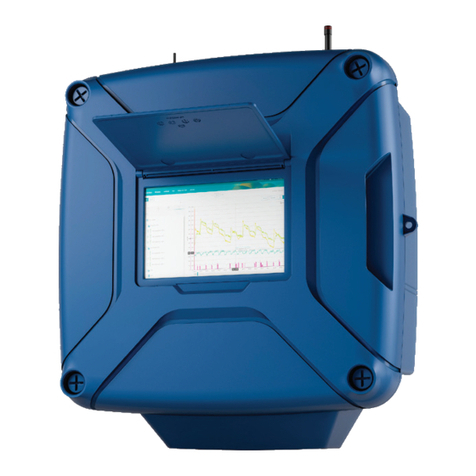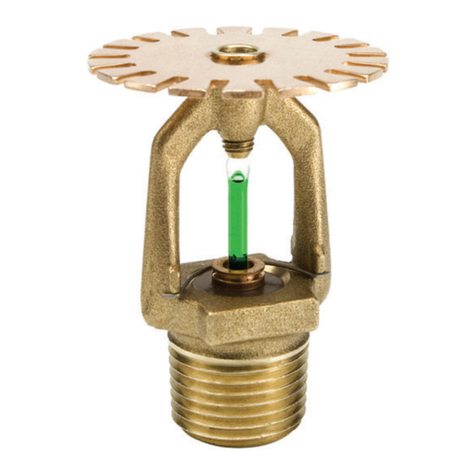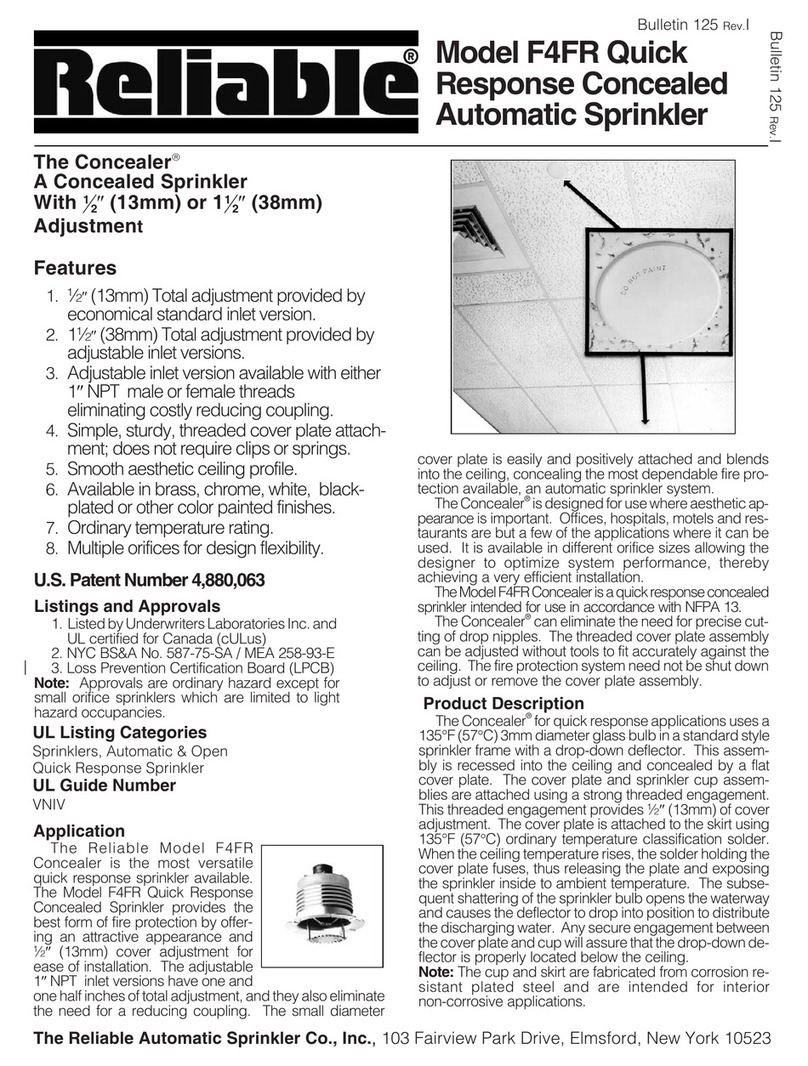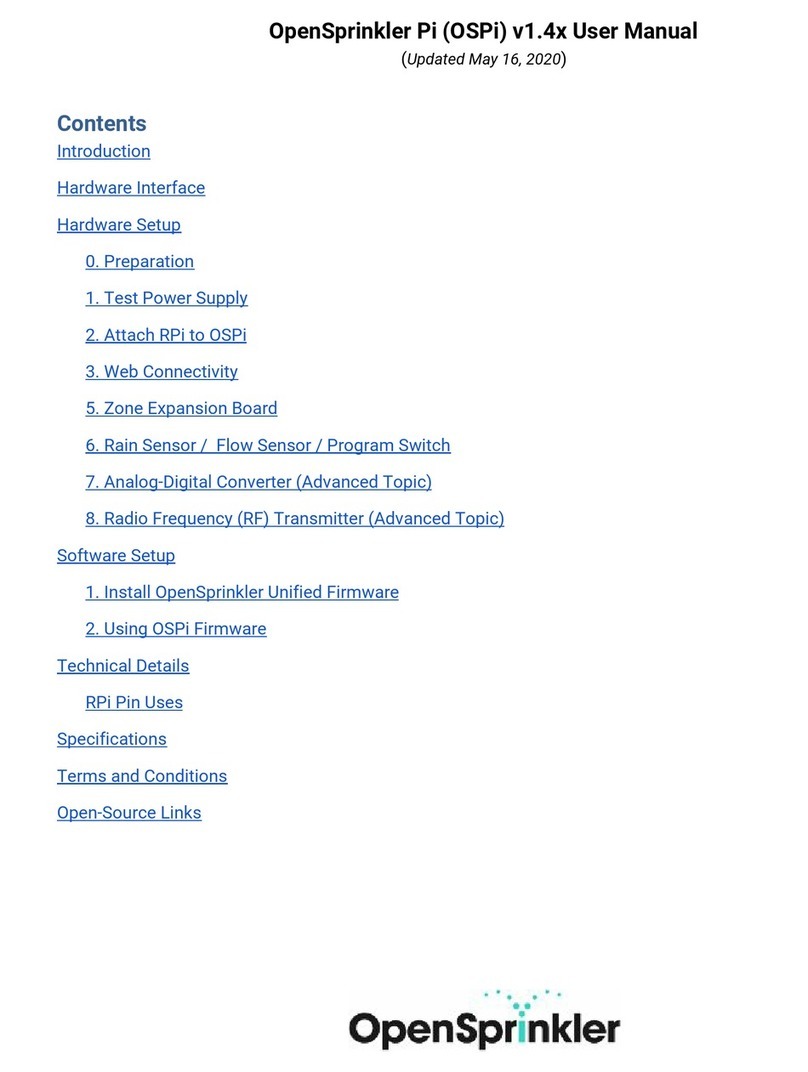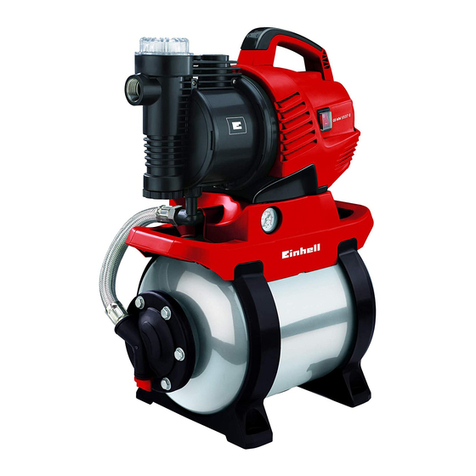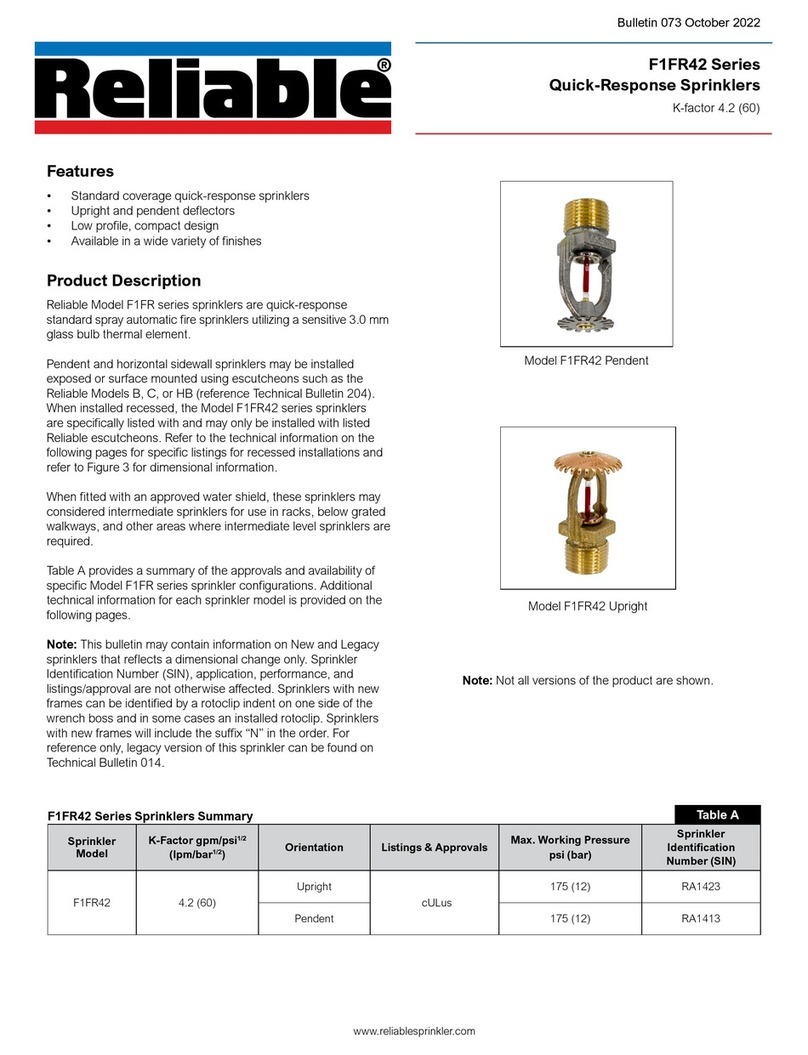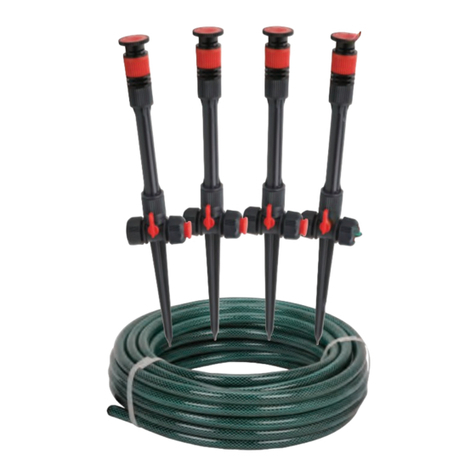
initiate a trouble alarm at the Firecycle®
III Control Panel (E.3).
If the detection system is damaged or
malfunctions, the Firecycle®III Control
Panel will initiate all appropriate alarms.
The Flow Control Valve (A.1), however,
will not open, and no water will enter
the system piping. If a sprinkler oper-
ates during this condition, water will fill
the system piping, activating any con-
nected alarms, and will discharge from
any opened sprinklers attached to the
system. The cycling function of the
Firecycle®III System will not operate in
this condition, and the system will need
to be manually turned off. All alarms will
operate normally.
Loss of AC Power Prior to Operation:
If the AC power fails, the Firecycle®III
System continues to operate on the
standby batteries. The Firecycle®III
Control Panel (E.3) will initiate a trouble
alarm and activate the piezo sounder. If
the AC power and the standby batteries
fail prior to the operation of the system,
all alarms will be lost. As long as air pres-
sure remains in the system piping, the
Pneumatic Actuator (B.6) will keep the
Flow Control Valve (A.1) from opening.
If the system air pressure is lost in this
condition, the Flow Control Valve (A.1)
will open, allowing water to flow into the
system piping and be discharged from
any open sprinklers. The cycling func-
tion of the system will not operate in this
condition, and the system must be man-
ually shut-off.
Loss of Power During Operation:
If all power fails while the system is flow-
ing water, the normally open Release
Solenoid #2 will fail open. The cycling
function of the system will not operate in
this condition, and the system must be
manually shut-off.
Manual Operation:
Any time the handle inside Emergency
Release (B.11) is pulled, pressure is re-
leased from the priming chamber faster
than it can be replaced through the prim-
ing line; the Flow Control Valve (A.1) will
open. Water will fill the system piping,
activating any connected alarms, but will
not discharge from any closed sprinklers
attached to the system until a sprinkler
has operated, as in a fire. The cycling
function of the Firecycle®III System will
not operate in this condition due to the
open Emergency Release (B.11). All
alarms will operate normally. After oper-
ating the Emergency Release (B.11), do
not close the Emergency Release until
the system is ready to be reset.
These fail-safe features ensure that the
Firecycle®III System continues to pro-
vide sprinkler protection even when the
detection system and/or the system pip-
ing have been damaged.
C. INSTALLATION
Refer to current Viking Technical Data
describing individual components of the
Viking Firecycle®III System. Technical
Data describing the Viking Flow Control
Valve and other system components are
packed with product and in the Viking
Engineering and Design Data book.
Also, refer to applicable installation stan-
dards, codes, and Authorities Having
Jurisdiction.
1. The Flow Control Valve (A.1) and
Trim must be installed only in areas
where they will not be subjected to
freezing temperatures.
2. All initiating devices (detectors), indi-
cating appliances, and releasing de-
vices must be compatible and ap-
proved for use with the Firecycle®III
System. Refer to appropriate Fire
Protection Equipment Approval
Guides and current Viking Technical
Data describing individual compo-
nents of the Viking Firecycle®III Sys-
tem.
D. EMERGENCY INSTRUCTIONS
(Refer to Figure 1 or 2 on page 426 d.)
Taking System Out of Service:
WARNING: Placing a control valve or
detection system out of service may
eliminate the fire protection capabilities
of the system. Prior to proceeding, notify
all Authorities Having Jurisdiction. Con-
sideration should be given to employ-
ment of a fire patrol in the affected areas.
After a fire, verify that the fire is OUT and
that placing the system out of service
has been authorized by the appropriate
Authority Having Jurisdiction.
Sprinkler systems that have been sub-
jected to a fire must be returned to ser-
vice as soon as possible. The entire sys-
tem must be inspected for damage and
repaired or replaced as necessary.
1. If All System Components Are
Operational:
A. Open System Drain (D.3).
B. Silence alarms (optional).
1. To silence electric alarms con-
trolled by Firecycle®III Control
Panel (E.3), open the panel
and press “ALARM SILENCE”
2. To silence electric alarms not
controlled by Firecycle®III
Control Panel (E.1), close the
Alarm Shut-Off Valve (B.9).
Note: Electric Alarms con-
trolled by a pressure switch in-
stalled in the ½" (15 mm) NPT
connection for a Non- inter-
ruptible Alarm Pressure
Switch cannot be shut off until
the Flow Control Valve is reset
or taken out of service.
C. To return to service immediately
(when no maintenance or repairs
are required):
1. Close System Drain (D.3) if
opened in Step 1-A.
2. Restore system air pressure.
3. Open the Firecycle®III Control
Panel (E.3) and press “RE-
SET”.
4. Open the Alarm Shut-Off Valve
(B.9) (if it was closed in step
1-B.2 above).
5. Close the System Drain (D.3).
6. Verify that all valves are se-
cured in their normal operating
position. (Refer to Figure 1 or 2
on page 426 d.)
2. If it is necessary to remove the
Firecycle®III System from service:
A. Close the Main Water Supply con-
trol Valve (D.1).
B. Close Priming Valve (B.1) (op-
tional). If necessary, open the
System Drain (D.3) to drain sys-
tem and/or Test Valve (B.15) to
drain the inlet chamber of the Flow
Control Valve (A.1).
C. Disconnect all power sources to
the Firecycle®III Panel prior to
performing any maintenance or
repairs to the detection system
(E.4, E.5), the panel (E.3), sole-
noid valves (E.1, E.2), or any elec-
trical component of the system.
3. Perform all maintenance procedures
recommended in Firecycle®III
Owner’s Manual and Technical Data
Pages for the individual components
of the system that has operated.
A. Replace any piping, detectors
(E.4), or sections of detection ca-
ble (E.5) that have been dam-
aged.
Note: The complete system oper-
ation must be tested after servic-
ing, changing programming, addi-
tion or deletion of system compo-
nents, or after any modification,
repair, or adjustment to system
hardware or wiring. All compo-
nents, circuits, system operation,
or software functions known to be
affected by a change must be
100% tested.
B. Replace any sprinklers and/or
spray nozzles that have been
damaged or exposed to fire condi-
tions.
4. Restore AC power to Firecycle®III
Control Panel (E.3). Ensure that
standby batteries are charged or
charging.
Always connect and turn on AC
power source prior to connecting the
SYSTEM DATA
Firecycle®III 426 b March 15, 2004
FIRECYCLE®III
CYCLING DOUBLE
INTERLOCKED PREACTION
